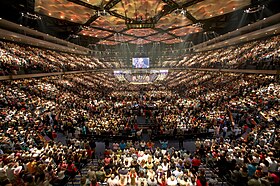Nondenominational Christianity
Nondenominational Christianity (or non-denominational Christianity) consists of churches which typically distance themselves from the confessionalism or creedalism of other Christian communities[1] by not formally aligning with a specific Christian denomination. Often founded by individual pastors, they have little affiliation with historic denominations, but typically adhere to evangelical Protestantism, and are a type of Protestantism.[2][3][4]
History
| Part of a series on |
| Christianity |
|---|
 |

The first non-denominational churches appeared in the United States in the course of the 20th century, in the form of independent churches.[5] They have experienced significant and continuous growth in the 21st century, particularly in the United States, where they represented the third largest Christian denomination in 2010.[6][7][8] In Asia, especially in Singapore and Malaysia, these churches are also more numerous, since the 1990s.[9]
Characteristics

The first characteristic is that non-denominational churches are not affiliated with a denominational stream of evangelical movements, either by choice from their foundation or because they have detached themselves from their Protestant denomination of origin in their history.[10] However, this doesn't prevent them from working with other churches on specific matters, even those with denominational affiliations; in fact it is quite common.
Nondenominational churches are recognizable from the evangelical movement, even though they are autonomous and have no other formal labels.[11][12][13]
The movement is particularly visible in the megachurches.[14][15]
The neo-charismatic churches often use the term nondenominational to define themselves.[16]
Churches with a focus on seekers are more likely to identify themselves as non-denominational.[17]
Criticism
Boston University religion scholar Stephen Prothero argues that nondenominationalism hides the fundamental theological and spiritual issues that initially drove the division of Christianity into denominations behind a veneer of "Christian unity". He argues that nondenominationalism encourages a descent of Christianity—and indeed, all religions—into comfortable "general moralism" rather than being a focus for facing the complexities of churchgoers' culture and spirituality. Prothero further argues that it also encourages ignorance of the Scriptures, lowering the overall religious literacy while increasing the potential for inter-religious misunderstandings and conflict.[18]
See also
- Protestantism in the United States
- History of Protestantism in the United States
- Community Church movement
- Jesuism
- Local churches
- Non-church movement
- Non-denominational Muslim
- Non-denominational Judaism
- Postdenominationalism
- Sunday Christian
References
- ^ Confessionalism is a term employed by historians to refer to "the creation of fixed identities and systems of beliefs for separate churches which had previously been more fluid in their self-understanding, and which had not begun by seeking separate identities for themselves—they had wanted to be truly Catholic and reformed." (MacCulloch, The Reformation: A History, p. xxiv.)
- ^ Allan Anderson, An Introduction to Pentecostalism: Global Charismatic Christianity, Cambridge University Press, UK, 2013, p. 157
- ^ "Appendix B: Classification of Protestants Denominations". Pew Research Center - Religion & Public Life / America's Changing Religious Landscape. Retrieved 13 October 2019.
- ^ Nondenominational Congregations Research at Hartford Institute for Religion Research website. Hirr.hartsem.edu. Retrieved on 2010-11-03.
- ^ Roger E. Olson, The Mosaic of Christian Belief, InterVarsity Press, USA, 2016, p. 43
- ^ Hartford Seminary, Hartford Institute for Religion Research, Nondenominational & Independent Congregations, hirr.hartsem.edu, USA, accessed December 14, 2018
- ^ Michael De Groote, The rise of the nons: Why nondenominational churches are winning over mainline churches, deseretnews.com, USA, February 25, 2011
- ^ Vincent Jackson, How non-denominational churches are attracting millennials, pressofatlanticcity.com, USA, February 2, 2017
- ^ Peter C. Phan, Christianities in Asia, John Wiley & Sons, USA, 2011, p. 90-91
- ^ Gabriel Monet, L'Église émergente : être et faire Église en postchrétienté, LIT Verlag Münster, Switzerland, 2013, p. 135-136
- ^ Pew Research Center, AMERICA'S CHANGING RELIGIOUS LANDSCAPE, pewforum.org, USA, May 12, 2015
- ^ Ed Stetzer, The rise of evangelical 'nones', cnn.com, USA, June 12, 2015
- ^ Peter C. Phan, Christianities in Asia, John Wiley & Sons, USA, 2011, p. 90
- ^ Sébastien Fath, Dieu XXL, la révolution des mégachurches, Édition Autrement, France, 2008, p. 25, 42
- ^ Bryan S. Turner, Oscar Salemink, Routledge Handbook of Religions in Asia, Routledge, UK, 2014, p. 407
- ^ Allan Anderson, An Introduction to Pentecostalism: Global Charismatic Christianity, Cambridge University Press, UK, 2013, p. 66
- ^ Kimon Howland Sargeant, Seeker Churches: Promoting Traditional Religion in a Nontraditional Way, Rutgers University Press, USA, 2000, p. 28
- ^ Prothero, Stephen (2007). Religious Literacy: What Every American Needs to Know - and Doesn't. New York: HarperOne. ISBN 0-06-084670-4.
